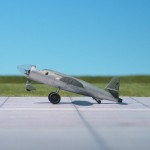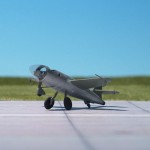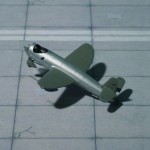TYPE: Experimental plane
ACCOMMODATION: Pilot only
POWER PLANT: Walter HWK R1-203 liquid fuelled rocket engine, rated at 500 kp
PERFORMANCE: 466 mph
COMMENT: The Heinkel He 176 was a German rocket-powered aircraft. It was the world’s first aircraft to be propelled solely by a liquid-fuelled rocket, making its first powered flight on 20 June 1939. It was a private venture by the Heinkel Company in accordance with director Ernst Heinkel’s emphasis on developing technology for high-speed flight. The performance of the He 176 was not spectacular, but it did provide “proof of concept” for rocket propulsion.
During the 1920s, German daredevils had experimented with using solid-fuel rockets to propel cars, motorcycles, railway carriages, snow sleds, and, by 1929, aircraft such as Alexander Lippisch’s “Ente” and Fritz von Opel’s “RAK.1.
Solid-fuel rockets, however, have major disadvantages when used for aircraft propulsion, as their thrust cannot be regulated, and the engines cannot be shut down once fired.
In the late 1930s, Werner von Braun’s rocketry team working at Peenemünde investigated installing liquid-fuelled rockets in aircraft. Heinkel enthusiastically supported their efforts, supplying a Heinkel He 72 and later two Heinkel He 112 for flight tests. In early 1937, one of these latter aircraft was flown with its piston engine shut down during flight, at which time it was propelled by rocket power alone. At the same time, Hellmuth Walter’s experiments into Hydrogen peroxyd monopropellant-based rockets were leading towards light and simple rockets that appeared well-suited for aircraft installation.
The He 176 was built to utilise one of the new Walter engines. It was a tiny, simple aircraft, built almost entirely out of wood, but did possess an open cockpit with a little windshield and a frameless single-piece clear nose, through which the pilot’s rudder pedal mounts were visible. The landing gear was a combination of conventional and tricycle gear designs, with the main gear’s struts intended to retract rearwards into the fuselage, with a fixed, aerodynamically faired nose wheel and strut, and a retractable tail wheel. A unique feature of the He 176 was its jettisonable nose escape system. Compressed air was used to separate the nose from the aircraft. A drogue chute was used to reduce the opening force required. After the drogue was deployed, the flush-fitting cockpit canopy was released and a conventional pilot/parachute bailout occurred.
Heinkel demonstrated the aircraft to the RLM (Reichsluftfahrtministerium, Ministry of aviation), but official lack of interest led to the abandonment of the company’s rocket propulsion programme. Testing of the He 176 ended with only one aircraft being built. It was put on display at the Berlin Air Museum and was destroyed by an Allied bombing raid in 1943.
Prior to the cancellation of the programme, plans had been drawn up for a more sophisticated rocket-plane, still designated He 176. This was never constructed, but because it bore the same designation as the aircraft that was actually flown, many books and websites mistakenly publish pictures of it to illustrate its earlier namesake.
Germany did eventually fly an operational rocket-propelled fighter, the Alexander Lippisch-designed Messerschmitt Me 163 “Komet” (Comet), but this was made by the competing Messerschmitt firm, using an engine that was a further development of the one that powered the He 176 (Ref.: 24).














